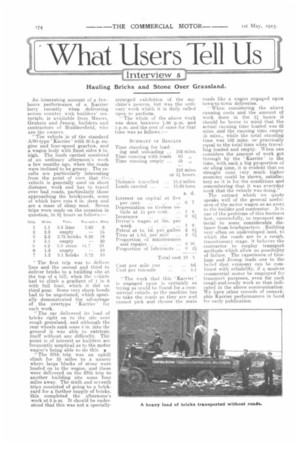What Users Tell Us , MISSIONSENTSMASESSMEESTESIent i n t erv i ew 5
Page 4

If you've noticed an error in this article please click here to report it so we can fix it.
Hauling Bricks and Stone Over Grassland.
An interesting account of a fewhours performance of a Karrier lorry recently when delivering across country with builders' materials, is available from Messrs. Graham and Jessop, builders and contractors of Huddersfield, who are the owners.
"The vehicle is of the standard A/80-type Karrier ' with 30 h.p. engine and four-speed gearbox, and a wagon body with fixed sides 9 in. high. The loads carried consisted of an ordinary afternoon's work a few months ago, when the roads were inclined to be greasy. The results are particularly interesting from the point of view that tha, vehicle is generally used on short distance work and has to travel over bad roads, particularly those approaching the brickyards, some of which have ruts 6 in. deep and are a mass of slimy mud. Seven trips were made on the occasion in question, in 31 hours as follows:—
Trip. Mile. Tong. Ton-unli-s. Mins.
1 1.1 3.3 lime 3.63 9 2 2.2 empty 15
3 2.2 3.75 bricks 8.25 18 4 3.1 empty — 20 5 4.2 3.5 stone 14.7 28 6 1.2 empty — 10 7 1.2 3.1 bricks 3.72 10 "The first trip was to deliver lime and the second and third to deliver bricks to a building site at the top of a hill, when the vehicle had to climb a gradient of 1 in 6 with full load, which it did on third gear. Some very sharp bends had to be negotiated, which specially demonstrated the advantage of the overtype 'Karrier' for such work.
"The car delivered its load of bricks right on to the site over rough grassland, and although the rear wheels sank some 4 in. into the ground it was able to extricatt itself without any difficulty. TM: point is of interest as builders are frequently sceptical as to the motor wagon's being able to do this. "The fifth trip was an uphill climb for 2/ miles to a, quarry where large blocks of stone were loaded on to the wagon, and these were delivered on the fifth trip to another building site some four miles away. The sixth and seventh trips consisted of going to a brickyard for a further supply of bricks, this completed the afternoon's work at 5 p.m. It should be understood that this was not a specially arranged exhibition of the machine's powers, but was the ordinary work which it is daily called Upon to perform.
"The whole of the above work was done between 1.30 p.m. and 5.p.m. and the cost of same for that time was as follows :—
SUMMARY OF RESULTS.
Time standing for loading and unloading ... 102 mins. Time running with loads 63 „ Time running empty ... 45 „ 210 mins. or 3i hours.
Distance travelled 15.2 miles.
Loads carried ... 13.65 tons.
s. d.
Interest on capital at five per cent. ... ... ... Depreciation on tireless ve hicle at 15 per cent. ... 1 8 Insurance ... ... ... 0 31 Driver's wages at 35s. per week ... ... ... 1 8 Petrol at Is. Id. per gallon 2 8 Tires at 1.8(1. per mile ... 2 31 Proportion of maintenance and repairs ... ... ... 0 10 Proportion of lubricants ... 0 2i 07 Total cost 10 3 Cost per mile rim Cost per ton-mile 8d.
4.1 " The work that this ' Karrier ' is engaged upon is certainly as trying as could be found for a commercial vehicle, as the machine has to take the roads as they are and cannot pick and choose the main roads like a wagon engaged upon town-to-town deliveries.
When considering the above running costs and the amount of work done in the 31 hours it should be borne in mind that the actual running time loaded was 63 mins. and the running time empty 45 mins., while the total standing time was 102 mins. or practically equal to the total time when travelling loaded and empty. When one considers the amount of work got through by the 'Karrier' in the time, with such a big proportion of str .1ding time, it is evident that on straight runs very much higher economy could be shown, satisfactory as it is for the conditions and remembering that it was everyday work that the vehicle was doing."
The extract which we quote speaks well of the general usefulness of the motor wagon as an asset to the builder and contractor. It is one of the problems of this business how, successfully, to transport material to some considerable distance from headquarters. Building very often on undeveloped land, to which the roads are in a rough, transitionary stage, it behoves the contractor to employ transport methods which allow no possibility of failure. The experience of Graham and Jessop leads one to the belief that economy can be combined with reliability, if a modern commercial motor be employed for transport purposes, even for such rough-and-ready work as that indicated in the above communication. We have other records of remarkable Karrier performances in hand for early publication.


























